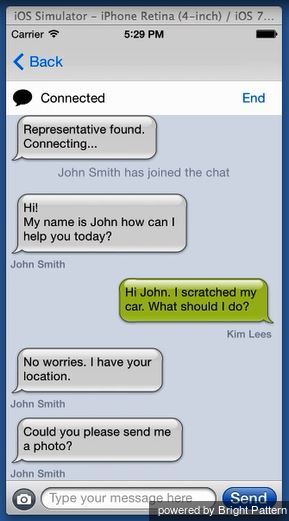m (Tracy moved page 5.3:Agent-guide/Work/Mobile/About to 5.3:Agent-guide/Work/Mobile/Overview) |
|||
| Line 1: | Line 1: | ||
| − | <translate>= | + | <translate>= Overview= |
Customers have increasingly been able to contact businesses via applications that they download to their smartphones. Such applications were originally designed for self-service and web-form inquiries. More recently, however, web and mobile applications have begun to support live interactions, including chat, voice, and video calling. The picture below shows an example of a customer communicating with an insurance agent via a mobile chat application. | Customers have increasingly been able to contact businesses via applications that they download to their smartphones. Such applications were originally designed for self-service and web-form inquiries. More recently, however, web and mobile applications have begun to support live interactions, including chat, voice, and video calling. The picture below shows an example of a customer communicating with an insurance agent via a mobile chat application. | ||
Revision as of 22:40, 22 January 2019
Overview
Customers have increasingly been able to contact businesses via applications that they download to their smartphones. Such applications were originally designed for self-service and web-form inquiries. More recently, however, web and mobile applications have begun to support live interactions, including chat, voice, and video calling. The picture below shows an example of a customer communicating with an insurance agent via a mobile chat application.
Thus, depending on your service configuration, you may be expected to handle interactions that customers initiate via such smartphone applications. Generally speaking, you handle mobile voice and chat interactions in the same way that you handle regular service calls and service chats. A few differences that you may need to be aware of while handling mobile interactions are discussed in the sections that follow.

